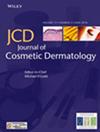Development and Validation of the Isotretinoin Hesitancy Scale for Acne Vulgaris: A Preliminary Study
IF 2.3
4区 医学
Q2 DERMATOLOGY
引用次数: 0
Abstract
BackgroundOral isotretinoin is the most effective systemic treatment for acne patients who fail to respond to other forms of therapies. However, hesitations and concerns regarding its side effect profile may detain the patients from treatment. This study aimed to develop and validate the Isotretinoin Hesitancy Scale (IHS) among acne patients.MethodsA cross‐sectional study was conducted with 100 acne patients who had not used isotretinoin previously. A 22‐item scale was created based on the related literature and expert opinions. The items of the scale related to beliefs and worries about isotretinoin were formatted with response options: agree, indecisive, and disagree. In this study, construct validity was tested with exploratory factor analysis, and reliability was tested with internal consistency and split‐half reliability.ResultsThe results of exploratory factor analysis indicated a three‐factor solution with a total of 14 items, explaining 57% of the total variance. The first factor (Hesitancy Related to Reversible Adverse Effects: 6 items) accounted for 30% of the variance, the second factor (Hesitancy Related to Irreversible Adverse Effects: 4 items) accounted for 16% of the variance and the third factor (Isotretinoin‐related Anxiety: 4 items) accounted 11% of the variance. The internal consistency of the three factors was calculated as 0.79, 0.78, and 0.72, respectively. The Cronbach's alpha score of the total scale was found to be 0.81, and split‐half reliability was found to be 0.87.ConclusionsThe IHS is the first scale that provides a valid and reliable assessment of isotretinoin hesitancy in acne patients. Eliminating isotretinoin hesitancy may reduce acne‐related clinical and psychosocial consequences.开发和验证治疗大疱性痤疮的异维A酸犹豫量表:初步研究
背景口服异维A酸是对其他疗法无效的痤疮患者最有效的系统治疗方法。然而,对其副作用的犹豫和担忧可能会阻碍患者接受治疗。本研究旨在开发并验证痤疮患者的异维A酸犹豫量表(IHS)。方法:本研究对100名之前未使用过异维A酸的痤疮患者进行了横断面研究。根据相关文献和专家意见编制了一个包含 22 个项目的量表。量表中与对异维A酸的信念和担忧相关的项目均设置了回答选项:"同意"、"犹豫不决 "和 "不同意"。本研究采用探索性因子分析对建构效度进行了检验,并采用内部一致性和分半信度对信度进行了检验。结果探索性因子分析结果表明,该量表有三个因子,共有 14 个项目,解释了总方差的 57%。第一个因子(与可逆不良反应相关的犹豫:6 个条目)占方差的 30%,第二个因子(与不可逆不良反应相关的犹豫:4 个条目)占方差的 16%,第三个因子(与异维甲酸相关的焦虑:4 个条目)占方差的 11%。三个因子的内部一致性分别为 0.79、0.78 和 0.72。结论IHS是第一个对痤疮患者异维A酸犹豫不决进行有效、可靠评估的量表。消除异维A酸犹豫可能会减少与痤疮相关的临床和社会心理后果。
本文章由计算机程序翻译,如有差异,请以英文原文为准。
求助全文
约1分钟内获得全文
求助全文
来源期刊

Journal of Cosmetic Dermatology
DERMATOLOGY-
CiteScore
4.30
自引率
13.00%
发文量
818
审稿时长
>12 weeks
期刊介绍:
The Journal of Cosmetic Dermatology publishes high quality, peer-reviewed articles on all aspects of cosmetic dermatology with the aim to foster the highest standards of patient care in cosmetic dermatology. Published quarterly, the Journal of Cosmetic Dermatology facilitates continuing professional development and provides a forum for the exchange of scientific research and innovative techniques.
The scope of coverage includes, but will not be limited to: healthy skin; skin maintenance; ageing skin; photodamage and photoprotection; rejuvenation; biochemistry, endocrinology and neuroimmunology of healthy skin; imaging; skin measurement; quality of life; skin types; sensitive skin; rosacea and acne; sebum; sweat; fat; phlebology; hair conservation, restoration and removal; nails and nail surgery; pigment; psychological and medicolegal issues; retinoids; cosmetic chemistry; dermopharmacy; cosmeceuticals; toiletries; striae; cellulite; cosmetic dermatological surgery; blepharoplasty; liposuction; surgical complications; botulinum; fillers, peels and dermabrasion; local and tumescent anaesthesia; electrosurgery; lasers, including laser physics, laser research and safety, vascular lasers, pigment lasers, hair removal lasers, tattoo removal lasers, resurfacing lasers, dermal remodelling lasers and laser complications.
 求助内容:
求助内容: 应助结果提醒方式:
应助结果提醒方式:


